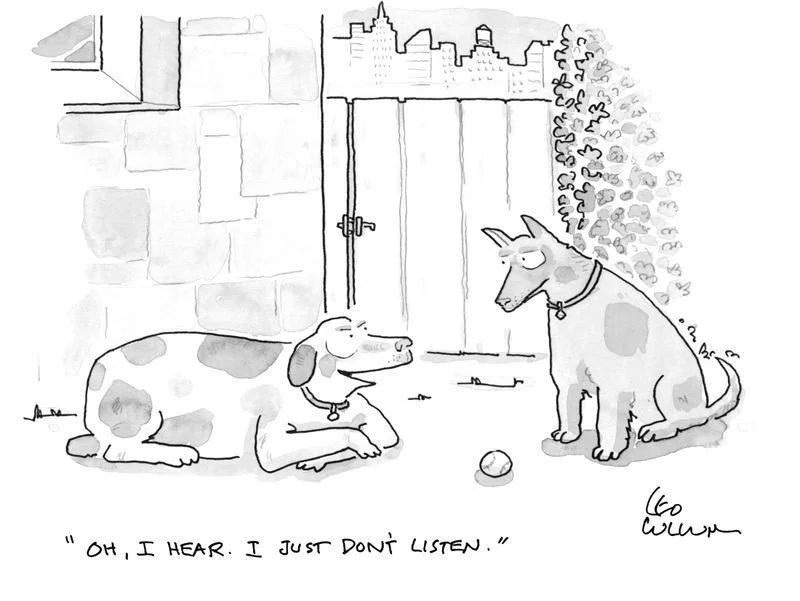Active Listening
Effective leadership starts with truly hearing those around you. Active listening goes beyond hearing words; it involves understanding emotions, concerns, and perspectives, creating an environment where people feel valued and respected.
To grasp the significance of active listening in leadership, it's essential to understand the fundamental components of effective communication. In every conversation, participants have two goals: to accurately understand the message being communicated—capturing both its explicit content and the underlying emotions—and to demonstrate their interest, engagement, and compassion towards the other person. This second goal matters not only because it reflects kindness, but because when people feel unheard, they tend to withdraw.
Distractions are common, and meaningful listening often takes a backseat. Yet, leaders who make active listening a priority strengthen their relationships, create a culture of collaboration, and improve overall decision-making.
Self-Assessment: Active Listening
Please take a few moments to contemplate the following self-reflection questions. Where can you identify opportunities for personal growth in your leadership?
1. Do I actively listen when others are speaking, without interrupting or formulating my response prematurely?
2. Do I give the speaker my full attention during conversations?
3. Am I genuinely interested in understanding the speaker's perspective?
4. Am I skilled at asking probing questions to better understand others' perspectives?
5. Can I recall key details from recent conversations and discussions?
6. Do I maintain eye contact and use non-verbal cues to show I’m engaged?
7. Do I demonstrate empathy and understanding toward the speaker's feelings and concerns?
8. Do I avoid passing judgment or making assumptions about what the speaker is saying?
Remember, this self-assessment is just a starting point for understanding your knowledge of Active Listening as a leader. It's essential to reflect on your responses and actively work on areas where improvement is needed. Additionally, working with your ECFL Leadership Coach or seeking feedback from a trusted mentor can provide valuable insights into your strengths and weaknesses.
“One of the most sincere forms of respect is actually listening to what another has to say.”
Recently, the Ken Blanchard Companies conducted a leadership survey of over 800 professionals to identify the most critical leadership skills needed in their organizations. At the top of the list? Listening. It ranked above other leadership skills such as building trust or managing change.
Blanchard’s study confirms what many of us know: the most important leadership skill needed for success is listening. Listening is a skill that costs virtually nothing but can produce incredible results. If we hope to have any degree of personal success, we have to listen well to our bosses, our teammates, and those whom we lead. Likewise, listening to our clients is critical for success in business. And if we fail to listen to our family or our close friends, we will miss out on many of life’s greatest blessings.
“The quality of our listening determines the quality of our influence.”
The Foundations of Active Listening
Active listening is grounded in presence, empathy, and adaptability. These elements create the foundation for meaningful communication and trust.
Presence means giving your undivided attention to the speaker, free from distractions. When you focus entirely on the conversation, you demonstrate respect and encourage openness. This creates a safe space where individuals feel heard and valued.
Empathy takes active listening a step further by recognizing and validating emotions. Understanding what the speaker is feeling—not just what they are saying—builds trust and strengthens your connection. Simple acknowledgments like, “I can see why this matters to you,” make a big difference.
Adaptability ensures that your listening style meets the needs of the conversation. Whether it’s providing a supportive ear during a personal discussion or analyzing key points in a strategic conversation, tailoring your approach reinforces trust and effectiveness.
John Izzo, author of the book Stepping Up: How Taking Responsibility Changes Everything, believes active listening is crucial to getting the most out of employees:
“The bottom line is that people want to be heard and feel valued… When decisions are made without getting input from people, they tend to hold back their ideas and take less initiative to make improvements.”
In a setting like 3M Chem Ops, that dynamic often shows up in subtle ways, such as when someone hesitates to ask a follow-up, avoids voicing a concern, or chooses not to offer an idea. The following scenario illustrates how a leader’s presence during a simple exchange can either build trust or erode it.
Kim Ickle and the Missing Element
Kim Ickle was new to the process area and wanted to double-check a detail before starting her task. She approached her first supervisor, Mike, with a question. He stayed focused on his monitor, gave a quick response, and pointed toward a standard work guide without much eye contact. Kim thanked him and walked away still unsure if she had understood things correctly.
Later, Kim brought the same question to another supervisor, Daniel. This time, Daniel paused what he was doing, turned to face Kim, and listened without interrupting. He asked a few questions to better understand Kim’s concern and then repeated back part of what she had shared to make sure they were on the same page. The conversation was steady, and his tone was calm. Kim left with more clarity and felt more prepared to move forward.
Both supervisors had the same information, and both had experience. But only one made the effort to listen and make space for Kim.
These moments don’t always stand out in the middle of a shift, but they happen all the time and ultimately shape how our teams interact. When someone feels listened to, even briefly, they are more likely to return with the next question or idea. Trust begins in these small interactions and builds over time.
The difference in how each supervisor listened left an impression that shaped how Kim chose to engage, demonstrating the power of active listening. How would you have handled things?
Strong listening doesn’t always require long conversations or dramatic feedback. Often, it’s about staying present when it would be easier to multitask or rush through a reply. Leaders who treat listening as a discipline, not just a skill, create stronger teams and clearer direction. The following best practices offer a grounded approach to listening with more clarity and care.
Best Practices for Active Listening:
Be Fully Present: Focus completely on the conversation at hand by setting aside distractions like phones or emails. Being present shows the speaker that their thoughts are your priority. Even small gestures like maintaining eye contact and nodding convey genuine attention. This level of focus creates an atmosphere of respect and trust.
Show Empathy: Listen not just to the words being said but to the emotions behind them. Acknowledge feelings by saying things like, “It sounds like that was challenging for you,” or “I can see how that would be exciting.” Validating emotions strengthens connections and demonstrates that you care about the person, not just the message.
Ask Open-Ended Questions: Encourage deeper dialogue by asking questions like, “Can you tell me more about that?” or “What do you think could be a solution?” Open-ended questions invite the speaker to expand on their thoughts, providing you with a clearer understanding and fostering a collaborative conversation.
Paraphrase and Summarize: Restate what you’ve heard to confirm understanding and show that you’re engaged. For example, you might say, “So, what I’m hearing is that you’re concerned about meeting the deadline due to limited resources—is that correct?” This technique ensures clarity and prevents misunderstandings.
Be Patient: Avoid interrupting or rushing the speaker, even if the conversation feels slow. Give the speaker time to express their thoughts fully. Patience allows for deeper insights and signals that their perspective is valued, even in challenging or lengthy discussions.
Adapt to the Situation: Tailor your listening approach to fit the context. For example, if someone is sharing a problem, focus on empathetic listening. If they’re seeking advice, shift to a more solution-oriented approach. Flexibility ensures your response meets the speaker’s needs.
Follow Through: Active listening doesn’t end when the conversation does. Take action on any commitments made or provide updates where needed. Following through shows that you take the speaker’s input seriously and reinforces their trust in your leadership.
Model Positive Listening Habits: Set an example for others by consistently practicing active listening. This not only builds your credibility as a leader but also encourages a team-wide culture of open and respectful communication.
Mastering the art of active listening opens the door to richer, more authentic interactions. It invites a world where conversations are bridges to greater empathy, where every voice is heard, and where the depth of human connection is celebrated. Embrace these practices and embark on a journey toward becoming not just a better listener, but a better communicator, leader, and friend.
Active listening is a core part of communication, and it directly supports the 3MCOP pillar of Vision. Leaders who listen with presence and empathy help others feel heard, understood, and more willing to contribute. This kind of connection fosters clarity, alignment, and trust—three essential elements of long-term direction.
Active listening also reinforces operational discipline. It helps leaders gather accurate information, address concerns early, and follow through on what matters. At 3M Chem Ops, these habits strengthen consistency, engagement, and reliability across teams.
Leaders who listen well lead more clearly. They make it easier for others to speak up, solve problems, and move forward together with shared purpose and vision.
Reflection Questions:
What listening challenges do you face, and how do they impact your team or coworkers?
What strategies can you use to make sure that you’re fully present and engaged in conversations?
Has there been a time where you didn’t engage in active listening practices, and as a result, there was a negative consequence? What could you have done differently?
Strengthen your understanding of Active Listening by sticking with the following resources. Use this opportunity to note new insights and adhere to practices that will enhance your leadership journey.
The Art of Active Listening: The Harvard Business Review Guide
Amy Gallo (video)
Strategic Listening: How Managers, Coworkers, and Organizations Can Become Better at Listening
Mats Heide and Anette Svingstedt
Active Listening in the Workplace: How It Makes You a Stronger Manager
The Art of Listening
Simon Sinek (video)









